Porter Cable Temperature Heat Gun PC1500HGA Manual | Usage Instructions
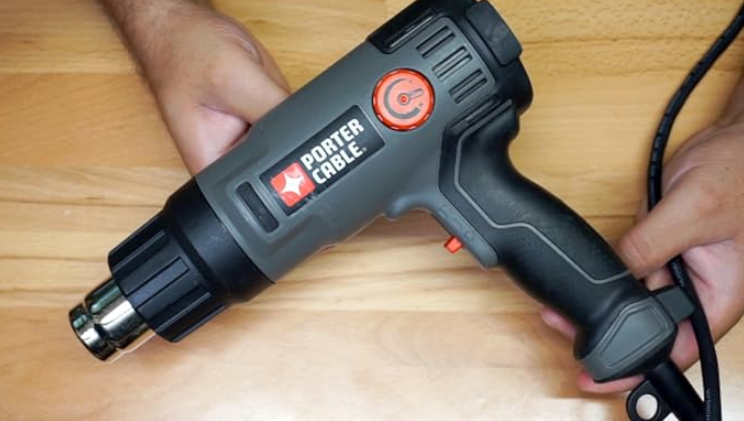
Content
Introduction Porter Cable Temperature Heat Gun PC1500HGA
The Porter Cable Temperature Heat Gun PC1500HGA is a powerful and versatile heat gun designed for a variety of industrial and commercial applications. This heat gun is capable of reaching temperatures up to 1,500 degrees Fahrenheit, making it an ideal tool for tasks such as shrink wrapping, thawing frozen pipes, soldering, bending plastic pipes, and more. With a durable and lightweight design, the PC1500HGA is easy to use and provides reliable performance, even in the most demanding environments. The estimated price for this heat gun is around $70 to $90, and it is now available in the market for purchase.
Porter Cable ACCESSORIES
WARNING: The use of any accessory not recommended for use with this tool could be hazardous. Always unplug the tool before attaching or removing accessories. Do not remove accessory tips until the tool has cooled to room temperature.
The following attachments are included with the PC1500HGA Heat Gun.
FAN NOZZLE
Wider distribution of the hot air, for working on large surfaces- floors, doors, etc.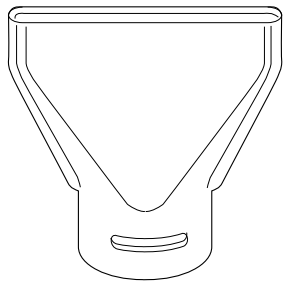
GLASS PROTECTOR
Safer working near glass. Distributes heat away from area to be protected.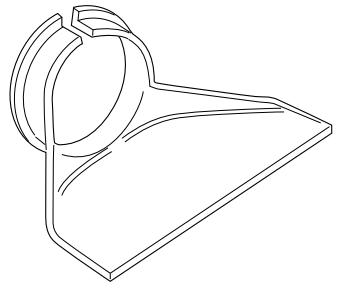
CONE NOZZLE
For precise operations- concentrates the air onto a smaller surface area.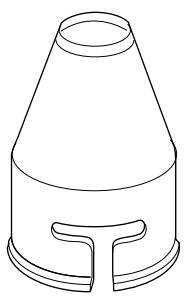
SPOOL REFLECTOR
Evenly dispenses air around whole object. Ideal for soldering pipework, shrink sealing electrical cable.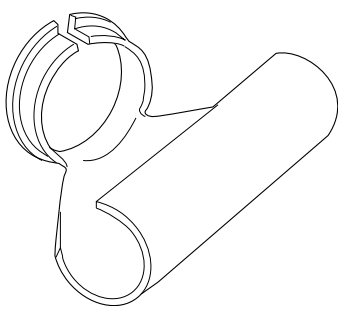
CAUTION: These nozzles remain hot after use. Use care in handling them.
Detailed Specifications
The Porter Cable PC1500HGA Heat Gun boasts several key features that make it a standout tool in its class. These features include:
- Dual temperature settings: high (1,500 degrees Fahrenheit) and low (750 degrees Fahrenheit)
- Built-in stand for hands-free operation
- Ceramic heating element for long-lasting durability
- Variable speed dial for precise control
- Integrated hang ring for easy storage
- Lightweight and ergonomic design for comfortable use
- Power cord length: 6 feet
- Weight: 2.1 pounds
Functional Description Heat Gun PC1500HGA
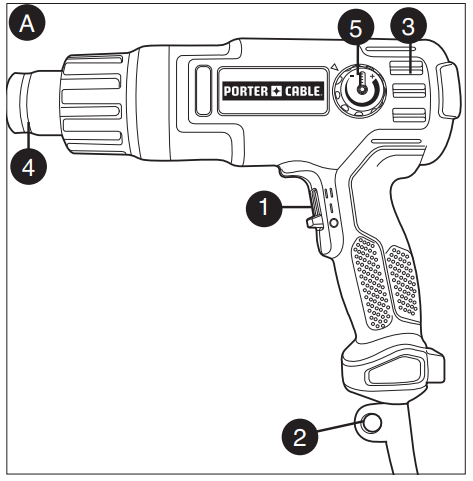
- Two speed switch
- Hang hole
- Air vents
- Hot air nozzle
- Temperature adjustment knob
Tool Operation of Porter Cable PC1500HGA
SWITCH
The position of the switch controls both the fan speed and the heat output of the gun. There is considerable overlap in the temperature ranges with the use of the temperature adjustment knob.
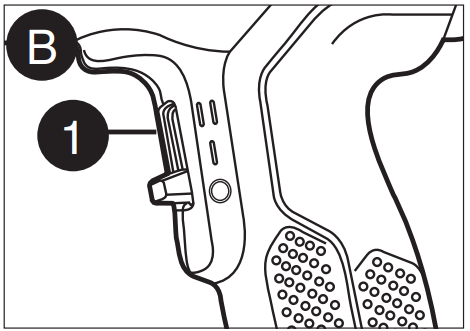
- To turn the tool on in low air speed, low heat, slide the switch (1) to the position marked “I”.
- To turn the tool on in high air speed, high heat , slide the switch (1) to the position marked “II”.
- To turn the tool off, slide the switch (1) to the position marked “0”.
TEMPERATURE ADJUSTMENT KNOB
- To raise the air temperature, turn the knob (5) clockwise.
- To lower the air temperature turn the knob (5) counterclockwise.
REMOVING PAINT
- Efficient paint removal requires the development of technique. Follow the guidelines in this manual and youʼll find that you will have mastered the procedure after a few simple projects.
- Turn on the tool and hold the nozzle about one inch (25mm) from the surface to be stripped, as shown in figure D. (Give the unit about 15-20 seconds running time to reach its full heat potential.)
- The paint being heated will usually begin to blister when it reaches the proper temperature for stripping.
- When it reaches this point begin scraping with smooth, even strokes. If the paint is sufficiently hot and the scraper is properly suited to the surface being stripped, the paint should come off in a strip equal to the full width of the scraper. Move the unit slightly ahead of the scraper to assure that the paint being stripped is softened.
- Best results will be achieved if the heat gun is moved slowly, but constantly, from side to side to evenly distribute heat.
- Do not linger or pause in one spot. Remember that splinters and small particles of stripped paint can be ignited and blown through holes and cracks in the surface being stripped.
HINTS ABOUT PAINT STRIPPING
- A smooth, downward scraping action will give good results and will help to prevent gouging the work surface.
- With some paints, prolonged heating will actually make them tougher to strip. Try a few different heating times until you develop the technique best suited to your particular application. The heat gun is designed to remove both oil based and latex based paints. It will not remove stains or primer coats that have impregnated the wood grain.
- Scrape paint as soon as it softens, it will soon cool and harden again. Clean the edge of your scraper often to retain a clean, sharp edge. Shield areas adjacent to where youʼre scraping.
For example: shield the door with nonflammable materials if youʼre stripping the door frame. - Donʼt concentrate the tools heat on a window pane or other glass surface. Excessive heat may crack the glass. Use some nonflammable material to shield the glass when stripping the window frame.
OTHER USES
For hands free operation, place the heat gun on a flat surface as shown in figure E. Aside from stripping paint, your heat gun has a wide array of other uses. Use it for softening linoleum and floor tile and for loosening heat sensitive adhesives. Itʼs perfect for use with heat shrinkable tubing and anywhere you need a portable heat source. You can even use it to thaw frozen metal water pipes.
Automotive uses include reducing set up time on body fillers or drying time on paints (the product manufacturerʼs recommendations must be followed.) Caution must be exercised around gasoline, automotive fluids, tires, gaskets, upholstery and hoses, etc. to prevent damage or fires. Be constantly aware that this tool can ignite flammable materials and soften or melt others. Avoid overheating adjacent flammable materials such as wood, insulation, electrical wiring jackets or plastic. Thaw only those metal pipe sections that are fully exposed. Do not attempt to thaw pipes that are inside walls, floors, ceilings, or otherwise enclosed. Do not attempt to thaw pipes that are wrapped in insulation.
USE OF EXTENSION CORDS
Make sure the extension cord is in good condition before using. Always use the proper size extension cords with the tool – that is, proper wire size for various lengths of cord and heavy enough to carry the current the tool will draw. Use of an undersized cord will cause a drop in line voltage resulting in loss of power and overheating. For proper size cords see chart below.
| Volts | Total Length of Cord in Feet | Amperage Rating | American Wire Gage |
|---|---|---|---|
| 120V | 0-25 (0-7,6m) | More Than 0 - Not more Than 6 | 18 |
| 26-50 (7,6-15,2m) | More Than 6 - Not more Than 10 | 16 | |
| 51-100 (15,2-30,4m) | More Than 10 - Not more Than 12 | 16 | |
| 101-150 (30,4-45,7m) | More Than 12 - Not more Than 16 | 14 | |
| Not Recommended | |||
| 240V | 0-50 (0-15,2m) | ||
| 51-100 (15,2-30,4m) | 14 | ||
| 101-200 (30,4-60,9m) | 12 | ||
| 201-300 (60,9-91,4m) |
MOTOR
Be sure your power supply agrees with nameplate marking. 120 Volts AC only means your tool will operate on standard 60 Hz household power. Do not operate AC tools on DC. A rating of 120 volts AC/DC means that you tool will operate on standard 60 Hz AC or DC power. This information is printed on the nameplate. Lower voltage will cause loss of power and can result in over-heating. All Porter Cable tools are factory-tested; if this tool does not operate, check the power supply.
Description
The Porter Cable PC1500HGA Heat Gun is a high-performance tool designed for professionals who demand reliable and consistent heat output. Its dual temperature settings make it suitable for a wide range of applications, from shrink wrapping and thawing to bending and soldering. The ceramic heating element ensures long-lasting durability, while the variable speed dial allows for precise temperature control. The built-in stand and integrated hang ring make it easy to use and store, while the lightweight and ergonomic design ensure comfortable use, even during prolonged periods of operation.
Porter Cable Maintenance
- Use only mild soap and damp cloth to clean the tool.
- Never let any liquid get inside the tool; never immerse any part of the tool into a liquid.
Setup Guide
Setting up the Porter Cable PC1500HGA Heat Gun is a straightforward process. Here are the steps to follow:
- Plug in the heat gun and allow it to warm up for a few minutes.
- Select the desired temperature setting using the switch on the handle.
- Adjust the speed dial to control the airflow.
- Place the heat gun in the desired position and hold it steady.
- Use the built-in stand to keep the heat gun upright when not in use.
Troubleshooting of Heat Gun PC1500HGA
| PROBLEM | POSSIBLE CAUSE | POSSIBLE SOLUTION |
|---|---|---|
| Unit will not start. | Cord not plugged in. | Plug tool into a working outlet. |
| Circuit fuse is blown. | Replace circuit fuse. (If the product repeatedly causes the circuit fuse to blow, discontinue use immediately and have it serviced at a Porter Cable service center or authorized service.) | |
| Circuit breaker is tripped. | Reset circuit breaker. (If the product repeatedly causes the circuit breaker to trip, discontinue use immediately and have it serviced at a Porter Cable service center or authorized service.) | |
| Cord or switch is damaged. | Have cord or switch replaced at a Porter Cable Service Center or Authorized Service Center. |
THREE YEAR WARRANTY
PORTER-CABLE will repair or replace, without charge, any defects due to faulty materials or workmanship for three years from the date of purchase for tools (two years for batteries). This warranty does not cover part failure due to normal wear or tool abuse. For further detail of warranty coverage and warranty repair information, visit www.portercable.com ,.This warranty does not apply to accessories or damage caused where repairs have been made or attempted by others. This warranty gives you specific legal rights and you may have other rights which vary in certain states or provinces. In addition to the warranty, PORTER-CABLE tools are covered by our:
1 YEAR FREE SERVICE: PORTER-CABLE will maintain the tool and replace worn parts caused by normal use, for free, any time during the first year after purchase.
90 DAY MONEY BACK GUARANTEE: If you are not completely satisfied with the performance of your PORTER-CABLE Power Tool for any reason, you can return it within 90 days from the date of purchase with a receipt for a full refund – no questions asked.
Pros & Cons
Pros
- Dual temperature settings for versatile use
- Ceramic heating element for long-lasting durability
- Variable speed dial for precise temperature control
- Lightweight and ergonomic design for comfortable use
- Built-in stand and integrated hang ring for easy storage
Cons
- May be too powerful for some light-duty applications
- Can get very hot, so caution is required when handling
Customer Reviews
Customers who have used the Porter Cable PC1500HGA Heat Gun generally have positive things to say about it. Positive comments include its powerful and consistent heat output, durable construction, and ease of use. Some customers have noted that it can get very hot, so caution is required when handling. The most common complaint is that the power cord could be longer, as 6 feet may not be sufficient for some applications.
Faqs
What safety precautions should I follow when using the Porter Cable Heat Gun PC1500HGA?
How do I select the appropriate temperature setting on my PC1500HGA heat gun?
What should I do if my Porter Cable Heat Gun stops working?
How do I maintain my Porter Cable Temperature Heat Gun PC1500HGA heat gun to ensure longevity?
How long does it take for the Porter Cable Temperature Heat Gun PC1500HGA to reach the set temperature?
How do I replace the nozzle on my Porter Cable Temperature Heat Gun PC1500HGA heat gun?
What are the signs that the heating element in my Heat Gun PC1500HGA needs replacement?
How can I effectively remove paint with my Porter Cable Temperature Heat Gun PC1500HGA?
Can the Porter Cable Temperature Heat Gun PC1500HGA be used continuously for extended periods?
What is the warranty period for the Porter Cable Temperature Heat Gun PC1500HGA?
Leave a Comment
